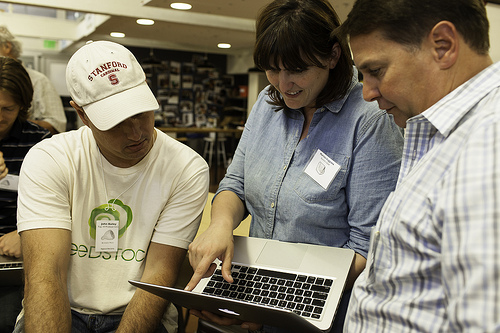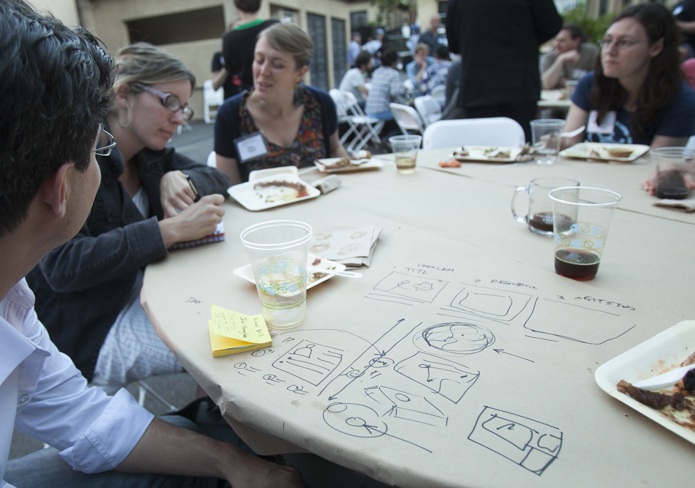
Marissa Guggiana of The Butcher’s Guild works with hackers at Hack//Meat SV. Photo Credit: Andre Hermann
We are at the beginning of the most radical transformation of our food industry since the Green Revolution. Until now, food innovation — including agricultural production, processing, distribution and retail — happened in the laboratories and strategy shops of a few select multinationals. These approaches to innovation have been proprietary, consolidated and designed to maximize shareholder interests. But as the Internet democratizes virtually every industry, like healthcare, media and education, it’s becoming increasingly clear that a more holistic future is possible. Leveraging information, technology and multidisciplinary design, we can begin to level the playing field between industrial and sustainable food. We can create a future that’s decentralized, collaborative and designed to maximize the interests of producers, eaters and the environment.
But as Tom Laskawy’s recent Grist article, ‘When it comes to food, technology won’t save us,’ underscores, many sustainable food advocates believe technology and the concept of scalability are incompatible with diversified sustainable food production. According to Laskawy, these technological innovations are at best a novelty, which he dismisses as “a theoretical, some might say fantastical, solution to problems we know how to solve but don’t really want to.”
I agree with Laskawy’s point that technology alone will not feed the world. Technology, however, is a broad term, encompassing everything from biotechnology, hardware and information technology, among other things. And there is a difference between scaling individual farms or food production operations, which often results in questionable practices or consolidation, and scaling an industry by making it easier for new players to enter the marketplace, which will be critical if we are going to meet growing demand for sustainably produced food.
There is a further misconception that the industry must choose between technological or traditional agriculture solutions. But technology can be used to optimize traditional solutions, by helping to streamline and better manage operations, more efficiently utilize resources and improve communications.
At Food+Tech Connect we believe information technology, in combination with multidisciplinary design, policy interventions and agroecological production practices can help the sustainable food industry scale in a way that preserves the industry’s integrity. Yet, challenges unique to food – like perishability, aversion to technology and industry fragmentation – must be addressed before game-changing innovation can offer the kinds of benefits for sustainable food that it has for other industries.
To address these challenges, we’re using hackathons—events during which volunteers self-organize to develop tools and solve problems in a short period of time—to bring people from diverse backgrounds together to co-create the future of food innovation.
Two weeks ago, we hosted our fourth such hackathon, Hack//Meat Silicon Valley, in partnership with Applegate and GRACE Communications Foundation. The event brought 250 food industry leaders (“steakholders”), technologists, creatives and entrepreneurs from across the country together to break down the industry’s biggest problems and develop solutions that could bridge the gap between pasture and plate.
When they arrived at Hack//Meat, leaders from the James Beard Foundation, The Butcher’s Guild, The American Grassfed Association, The Natural Resources Defense Council (NRDC) and the Niche Meat Processors Assistance Network knew little about technology and design.
And when hackers from Facebook, Google and other startups arrived, they knew little about the problems facing sustainable meat production and consumption. But over the course of the weekend, armed with sticky notes, white boards and locally sourced food, they collaboratively developed 24 technologies and business models, tackling issues like meeting growing demand for sustainably produced meat, consumer education around food labeling, whole animal utilization and celebrating the flavors of grassfed meat.
These technologies aim to make it easier for players along the sustainable meat supply chain to do business and communicate with their customers, and they have concrete applications. For example, the winning team at the Hack//Meat event in New York last December developed CARV, a Wi-Fi enabled scale and integrated software solution that captures critical data about individual cuts of meat. CARV’s team went on to present their concept at the New England Meat Conference, and to open source their key findings online. They are now applying for grants to continue development.
As Laskawy points out, this hackathon did not solve world hunger in one weekend, but that wasn’t the point. Our goal was to break down the problems in ways that encourage entrepreneurial problem solving. By getting top tech talent excited about tackling food issues, and helping farmers, processors, and advocates leverage new skills, we’ve encouraged both groups to become co-creators of future solutions.
Addressing the crowd of technologists and sustainable food stakeholders gathered at Hack//Meat Silicon Valley, Kevin Watt, a farmer and the leader of the event’s winning team, summed it up perfectly: “In the new farming world, this is my community.”




